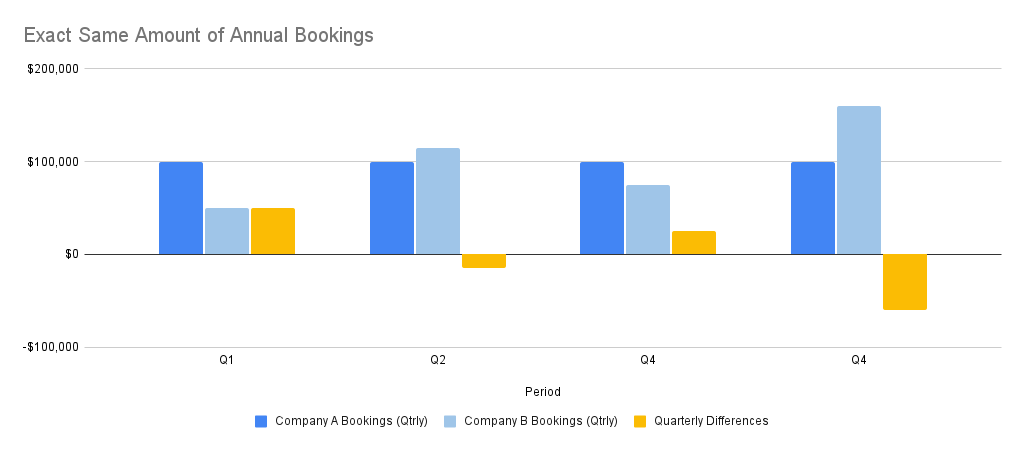The Price of Volatility
Imagine that when your favorite football team lined up for every play, each player chose his own play. While this approach occasionally worked well and the team won games from time to time, this approach was wildly inconsistent and difficult to predict success.
All too often, sales organizations operate similarly with similarly inconsistent results, ultimately delivering a few great successes and far too many disappointing failures. When reviewed by potential buyers, bids invariably get reduced because company buyers can't confidently believe in future (or current) revenues. With erratic (or no consistent) sales process and unpredictable customer retention numbers, offers invariably get reduced or withdrawn. The graphic below depicts quarterly profiles of two companies. They report the same annual cumulative bookings amount but they get there differently. Company B reflects a standard deviation in quarterly bookings (compared to forecast) of 21% compared to Company A. If you are Company B you are more volatile which equates to more risk which equates to a lower value. We estimate that if Company A traded at 4x revenue, Company B would trade closer to 3x given the 21% volatility measure.
All too often, sales organizations operate similarly with similarly inconsistent results, ultimately delivering a few great successes and far too many disappointing failures. When reviewed by potential buyers, bids invariably get reduced because company buyers can't confidently believe in future (or current) revenues. With erratic (or no consistent) sales process and unpredictable customer retention numbers, offers invariably get reduced or withdrawn. The graphic below depicts quarterly profiles of two companies. They report the same annual cumulative bookings amount but they get there differently. Company B reflects a standard deviation in quarterly bookings (compared to forecast) of 21% compared to Company A. If you are Company B you are more volatile which equates to more risk which equates to a lower value. We estimate that if Company A traded at 4x revenue, Company B would trade closer to 3x given the 21% volatility measure.

Fortunately, this consistency issue is easily rectified by installing and vigilantly following a sales methodology designed specifically for your business. Religiously following a sales process not only provides consistency of performance, but also provides confidence in projected sales forecasts. For SaaS companies, this sales process must include early qualification of price/value and an understanding of a compelling event (a date at which time the project needs to be in place and the financial consequences of it failing to be in place by that date).
Unfortunately, these two examples of sales process "must haves" are not included as part of many popular sales methodologies such as MEDDPIC, among others. These omissions are likely due to the fact that they are generic (and transactional) sales methodologies and not designed specifically and exclusively for SaaS companies. Selling SaaS, a more strategic sale, is different from selling more transactional sales and therefore, the process by which we sell needs to recognize these differences.
The omission of a "compelling event" focus is one of the primary reasons why deals stall and forecasts are inaccurate. Fortunately, it only takes two questions to understand the presence (or lack thereof) of a compelling event: "Why buy now?" (or whatever the forecasted timeframe is) and "What happens if you don't?". Responses such as "I've been directed to get this done by a certain date" or "We really need this project" are not compelling, but are often cited by sales reps when asked about a deal's forecasted timeline. The result is "slipped" or "mis-forecast" deals. Either way, the forecasted results aren't achieved. I'm sure that we all have desired purchases in our everyday lives that we really want, but don't follow with because of other priorities or other more compelling uses for our money.
The same is true in business and we need to focus on more than getting "selected" as the winner and more on gaining a better understanding of what is truly driving decisions and focus on those opportunities with truly compelling timelines. Sales reps are often drawn into competitive sales cycles that are likely to end in "no decision" because of the lack of a truly compelling event or failing to qualify the business need (Return on Investment) analysis early enough — before spending valuable resources on the effort and getting emotionally committed to pursuing the opportunity.
These are only two of the twenty-one steps that should be in every sales methodology. Without going into detail regarding each step, the key message is that consistent sales success, if driven by using a consistent sales approach across the sales team that is designed specifically for your type of sale (strategic or transactional), must be understood by the entire organization (organizational alignment is critical) and must be followed religiously.
In the end (at exit), your company will learn that your product was, in fact, your process, at least as much as the product or service sold. This process will be needed to defend your value at exit and accurately predict your future results. Just like all eleven players in football need to understand how to determine which play to be called for each situation and how to execute his/her role in that play, a sales team needs to operate similarly for consistent and predictable success.
For more information associated with deploying a proven sales methodology designed specifically for SaaS companies, please contact us at maximize@moicpartners.com.



.jpeg?width=352&name=Photo%20-%20shutterstock_1972218197%20(small).jpeg)